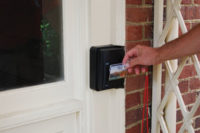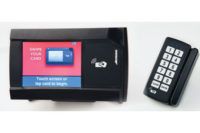Imagine the day when you can check-in and choose your hotel room using your mobile phone. You may soon be able to do that at Hilton hotels, as the chain says it will offer digital check-in and room selection at 11 of its brands, across more than 4,000 properties. The service will be available to Hilton HHonors members in more than 80 countries, the company said. “We analyzed data and feedback from more than 40 million HHonors members, as well as guest surveys, social media posts, and review sites, and it’s clear that guests want greater choice and control,” said Geraldine Calpin, SVP and global head of digital at Hilton Worldwide, in a statement.
Smartphone apps are the most recent wave of technology to hit the electronic access control arena. And while smartphone technology is just gaining popularity, all electronic access control systems have a number of advantages, which is why many businesses are making the switch from mechanical keys. These systems allow tracking, increased security, compliance with industry and/or insurance standards and restriction of unauthorized access. They are convenient and, in the long run, cost efficient.
Convenience
Networked electronic access control systems, where the locks communicate with a central computer, are inherently flexible and simple to use, from easily assigning electronic cards, badges and passcodes, to deactivating them with a few mouse clicks, to programming doors to stay unlocked during specific time periods. “One of the reasons we decided to convert to an electronic access control system was the convenience and the speed of being able to get to a location with your badge as opposed to having it unlocked for you or having to use your key,” says Mike Grupe, Director of Security at Williamson Medical Center in Franklin, Tennessee.
Grupe also appreciates the ease with which cards can be programmed and deactivated, as well as the way employees can be sorted into groups with access to only certain doors. “It makes the badge simple because a new employee can be dropped into a group and can access the doors they are supposed to,” he says. “We can also make temporary cards that allow a vendor or sales rep a short time of entrance. If someone is terminated or they leave, (even if) they have their badge, it’s a simple process to deactivate that badge, and it no longer functions. In addition, we can also set up an alarm if that person comes back later and tries to get in.”
Instead of having to use multiple keys, electronic access allows you to use just one card or passcode to get through the doors in your building, rather than having the old janitor key chain, says Stephen Kirkman, VP of Electronic Security at Global Security Services. “We have some areas that are locked that have medication that the doctors in a quick emergency situation can get into much faster than fumbling for keys or trying to get someone to call security officers to come and unlock it,” adds Grupe.
Another advantage: “With the click of a mouse, specific doors, entire wings, or even entire buildings, may be locked down or unlocked instantaneously,” says Emily Godefroid, an access control and electronic security coordinator in St. Louis, Missouri.
Grupe praises the use of “time zones.” “At certain times of the day, we may have the door unlocked, and that’s set in the computer, so it automatically unlocks during the day and locks when it’s supposed to,” he says. He also appreciates being able to temporarily program a door to do the same thing.
“The time savings are unbelievable,” adds Grupe. “With nearly 2,000 people, it makes a huge difference for us because we can get people in and out of areas and shut people out of places they’re not supposed to be. We can lock down the entire hospital in just a matter of a couple of minutes.” Adding a new hire to the system is quick and easy as well, he says.
Tracking Abilities
One of the greatest advantages of an electronic access control system is the ability to track in the form of an audit trail. “Administrators have the capability of running audit reports that are date and time stamped with information regarding who entered and exited a specific location and what time,” Godefroid says.
“There’s a tremendous amount of key control because we have around 2,000 employees,” Grupe adds. Audit trails are also invaluable for areas such as storage closets, where theft may occur.
Better Security
The higher tech the security system, the more secure it is, and electronic access control systems have the edge over mechanical keys. “Security breaches, or the threat of potential security breaches, often create a greater need for a higher and more efficient security system,” says Godefroid. “Possible security breaches could be as simple as a mechanical master key being lost or the mechanical keying system in use was not managed well, creating confusion regarding who actually has keys and to what spaces or buildings.”
Electronic access systems are more secure than mechanical systems because they have a digital signature for each user, says Steve Spatig, General Manager of Electronic Access Solutions at Southco Inc. Also, with a regular key, especially a master key, if you don’t get it back when an employee leaves or it gets lost, this creates security risks and reinstalling locks may be necessary, according to Jeremy Earles, Credentials Business Leader at Allegion, PLC.
Different Systems, Different Benefits
Often, companies use two different systems concurrently in order to meet certain standards, such as a keypad and a card reader, says Kirkman. “The thought behind that is if the employee loses the card or it gets stolen, somebody can’t just get in with their card. If they just give away their code, someone else can’t get in without the card too.” Cameras are also often utilized in conjunction with an electronic access control system of any type as well, so security officers can see who is actually gaining access, Kirkman says.
Keypads
Keypads are a great alternative for businesses with multiple, fluctuating customers, such as a 24-hour tanning salon or gym. “Instead of having cards that have to be reissued, and with thousands of customers, there would be thousands of cards out there, it’s much easier to just have a keypad on the side of the building so codes can be issued to individuals,” Kirkman says. Ideally, keypads should not be used in high security areas unless they are used in conjunction with another form of security, since codes can be easily lost or shared.
Magnetic Stripe Cards
These are the oldest type of electronic access with a fairly low level of security, but they are a low-cost option. Magnetic stripe cards are extremely easy to duplicate, says Earles, so they should be used for lower security environments.
Proximity Cards
These cards must be held within several inches of the reader, rather than inserted as magnetic stripe cards are. Each card has a facility number, along with its own individual number, embedded inside, so the numbers cannot be changed. Like magnetic stripe, though, they can be easily duplicated, Earles says, so they aren’t very secure either, though many companies still use them because of their simplicity.
Smart Cards
The highest level of contactless cards, smart cards have the greatest amount of security. They have encryption and can store data. These cards are very difficult to duplicate or break into, and since their cost is about the same as that of proximity cards, the majority of card manufacturers are pushing this technology in an effort to boost security, says Earles.
Smartphone Apps
Smartphone app-driven access control solutions have not been around for long and are just beginning to be used more often, but the convenience of not having to carry around a badge or key can’t be denied, since people typically have their phones with them at all times.
Apps also have greater security than mechanical keys or badges if they are stolen or lost. Phone data can be wiped remotely before anyone else has an opportunity to get into it, and most phones also have a pass code lock on them, making access difficult, says Earles.
Biometrics
Biometric systems are used for high security areas and typically require a fingerprint, retina scan, or hand geometry. “Biometric security is growing in popularity as well, but it is an expensive solution and normally used in conjunction with other electronic access control applications for highly restricted access areas,” says Godefroid.
The best electronic access control system really depends on the needs of the business, the standards they must follow, and their budget, says Kirkman. If a proximity card system is being considered, definitely look into smart cards as an alternative, since they offer much greater security and have virtually the same cost, Earles says. In general, if you have three or more doors in your building, it’s smart to consider electronic access control systems.




